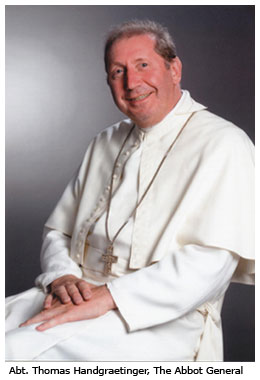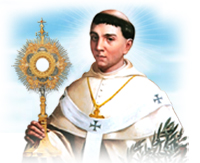History
On Christmas Day, 1121, after spending a year in prayer and meditation, Norbert and his followers made their first profession of vows, thus founding the Canons Regular of Premontre, also known as the Premonstratensians or Norbertines. The men and women vowed to seek Christ by living in common, sharing all things in holy poverty, and dedicating themselves to ministering to God’s People. Norbert’s dream continues to find expression almost 900 years later in the lives and ministries of his followers throughout the world, imitating the Jerusalem Christian community in a life "ever ancient, ever new."
In 1126, when the order received papal approbation by Pope Honorius II, there were nine houses; others were established in quick succession throughout Western Europe, so that at the middle of the fourteenth century there were some 1,300 monasteries for men and 400 for women. The Norbertines played a predominant part in bringing of Christianity to the territories around the Elbe and the Oder rivers.
The "Norbertines", also known as the Premonstratensians (O.Praem) and in Britain and Ireland as the White Canons (from the colour of their habit), are a Catholic religious order of canons regular founded at Prémontré near Laon in 1120 by Saint Norbert, who later became Archbishop of Magdeburg. Premonstratensians are designated by "O Praem" following their name Order of Premontre.
Saint Norbert had made various efforts to introduce a strict form of canonical life in various communities of canons in Germany. In 1120 he was working in the now-extinct Diocese of Laon, in the Picardie region of northeastern France. There, in a rural place, called Prémontré, he and thirteen companions established a monastery to be the cradle of a new order. As they were canons regular, they followed the Rule of St. Augustine, but with supplementary statutes that made their life one of great austerity. As the Premonstratensians are not monks but canons regular, their work often involves preaching and the exercising of pastoral ministry; they frequently serve in parishes close to their abbeys or priories.
By the beginning of the nineteenth century the order had become almost extinct, only eight houses surviving, all in Austria. However, there was something of a renaissance, and at the start of the twentieth century there were 20 monasteries and 1,000 priests. As of 2005, the number of monasteries had increased to nearly 100 and spread to every continent. In the twenty-first century, like all Canons Regular they follow the Augustinian Rule. According to the sources available there are some 1,000 male and 200 female members of the Order.
The Structure
As each abbey or priory is autonomous, practices and apostolates differ; some are contemplative in character at the same time others are highly active in pastoral ministry. However, each is guided by the Rule of Saint Augustine as well as the Constitutions established by the General Chapter which is held every 6 years. Demonstrating Norbertine unity, the general Chapter includes representatives from both male and female communities. The head of the Order, termed Abbot General, resides in Rome, and he is assisted in his duties by the Definitors (High Council) as well as commissions established for various aspects of the Order's life such as Liturgy and inter-abbey communications. On 30th Sep 2003 Abt. Thomas Handgraetinger is elected as the 64th Abbot General of Norbertine Order.
As of 2008, there are Premonstratensian abbeys or priories throughout the world: Australia, Austria, Belgium, Brazil, Canada, Chile, Czech Republic, Democratic Republic of the Congo, Denmark, France, Germany, Hungary, India, Ireland, Italy, Netherlands, Peru, Poland, Romania, Slovakia, South Africa, Spain, Switzerland, United Kingdom and USA.



